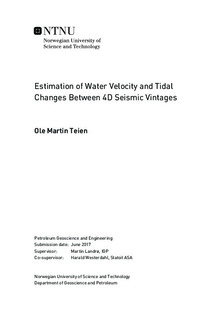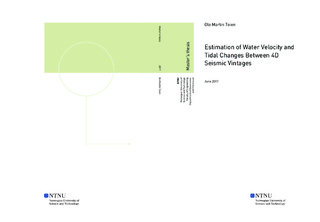| dc.contributor.advisor | Landrø, Martin | |
| dc.contributor.advisor | Westerdahl, Harald | |
| dc.contributor.author | Teien, Ole Martin | |
| dc.date.accessioned | 2019-09-11T09:01:13Z | |
| dc.date.created | 2017-06-26 | |
| dc.date.issued | 2017 | |
| dc.identifier | ntnudaim:17550 | |
| dc.identifier.uri | http://hdl.handle.net/11250/2615092 | |
| dc.description.abstract | Between the acquisitions of the vintages used in 4D seismic, both the seismic water velocity and the tidal level can change. These changes will create time shifts that reduce the 4D seismic's sensitivity to real changes in the reservoir and need to be corrected for in order to obtain optimal visualization of the production-related reservoir changes. In order to achieve good corrections, it is necessary to have precise estimates of the water column changes. Therefore, the goal of this Master's Thesis was to develop a method to precisely estimate the water velocity and tidal changes between the 4D seismic vintages. This goal has been fulfilled and the method developed is called "Time Shift Curve Inversion" (TSCI). The TSCI method utilizes inversion based on time shift curves showing water column induced time shift variation with offset. The time shift curves are found by a trace-by-trace cross-correlation of two seismic vintages. The forward modelling used in the inversion was based on a 1D raytracing model and the output of the TSCI method was the differences in water velocity, tidal level and the start of data delay between the vintages.
The TSCI method was tested on synthetic data and the results gave precise estimates of the water column changes for both realistic seismic and realistic subsurface models. In addition, the TSCI method proved to be robust to errors in the assumed water depth and base velocity in the background model used for forward modelling.
For the use of this project, Statoil provided with seismic data from two 4D vintages from the Snorre field. The TSCI method was applied to the data and resulted in consistent results and good match with other estimates of the water column changes.
To obtain best possible results with the TSCI method, the input seismic data need to be of good quality. The events included in the calculation need to have higher amplitudes than the surrounding signal, and the arrival times of the events need to be predicted precisely. In addition, differences in source positions between the vintages need to be corrected for.
There are parts of the TSCI method that can be developed further. Especially, the way the arrival time prediction is performed. The 1D raytracing model used in this project should be exchanged by a model that accounts for the variations along the sea floor. This is expected to increase the precision of the estimated water column changes. | en |
| dc.language | eng | |
| dc.publisher | NTNU | |
| dc.subject | Petroleumsfag, Petroleumsgeofysikk | en |
| dc.title | Estimation of Water Velocity and Tidal Changes Between 4D Seismic Vintages | en |
| dc.type | Master thesis | en |
| dc.source.pagenumber | 160 | |
| dc.contributor.department | Norges teknisk-naturvitenskapelige universitet, Fakultet for ingeniørvitenskap,Institutt for geovitenskap og petroleum | nb_NO |
| dc.date.embargoenddate | 2020-06-26 | |

